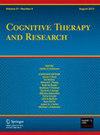马萨诸塞州总医院拔毛量表波兰版的信度、效度及因子结构
IF 2
3区 心理学
Q2 PSYCHOLOGY, CLINICAL
引用次数: 0
摘要
摘要目的麻省总医院拔毛量表(MGH-HPS)是一套包含7个条目的自报告工具,用于测量拔毛行为。该研究旨在评估波兰版MGH-HPS在成人样本中的心理测量特性。方法对1024名参与者(女性777人,男性241人,非二元性6人)进行在线筛查调查,其中92人(女性68人,男性24人)因确认至少偶尔有拔头发行为而被纳入研究;其中23人(占初始样本的2.25%)符合DSM-5拔毛障碍的标准。参与者被要求完成MGH-HPS的在线版本,抑郁焦虑压力量表-21项版本,强迫症清单-修订,以及包含DSM-5拔毛障碍标准的量表。对波兰版MGH-HPS量表的因子结构、信度、效度和诊断准确性进行检验。结果验证性因子分析表明,单因素模型和双因素模型均能较好地拟合数据;然而,考虑到各因素之间的高度相关性,单维模型可能更优。MGH-HPS总分与严重度因子、抗性因子和控制性因子具有较高的内部一致性、收敛效度和发散效度(Cronbach’s alpha分别为0.89、0.85和0.84)。ROC分析显示总分有足够的预后能力来区分临床和非临床拔毛受试者。最佳临界值为13分(灵敏度为100%,特异性为62.22%)。结论波兰版MGH-HPS是一种有效、可靠的成人拔毛行为测量工具。本文章由计算机程序翻译,如有差异,请以英文原文为准。

Reliability, Validity and Factor Structure of the Polish Version of the Massachusetts General Hospital Hair Pulling Scale
Abstract Purpose The Massachusetts General Hospital Hairpulling Scale (MGH-HPS) is a 7-item self-report tool that measures hair-pulling behaviors. The study aimed to assess the psychometric properties of the Polish version of the MGH-HPS in a sample of adults. Methods The online screening survey was completed by 1024 participants (777 women, 241 men, 6 non-binary), 92 of which (68 women, 24 men) were included in the study because they confirmed engaging in hair-pulling behaviors at least occasionally; 23 of those (2.25% of the initial sample) met the DSM-5 criteria for hair-pulling disorder. The participants were asked to complete the online version of the MGH-HPS, the Depression Anxiety Stress Scales-21-Item Version, the Obsessive Compulsive Inventory-Revised, and a scale containing the DSM-5 hair-pulling disorder criteria. The factor structure, reliability, validity, and diagnostic accuracy of the Polish version of the MGH-HPS were examined. Results The confirmatory factor analysis demonstrated that both a one-factor and a two-factor model fit the data well; however, given the high correlation between the factors, the unidimensional model may be superior. High internal consistency and convergent and divergent validity were obtained for the total score of the MGH-HPS and the Severity and Resistance and Control factors (Cronbach’s alphas: 0.89, 0.85 and 0.84 respectively). The ROC analysis indicated adequate prognostic ability of the total score to discriminate subjects with clinical and non-clinical hair-pulling. The optimal cut-off value was 13 points (sensitivity = 100%, specificity = 62.22%). Conclusions The Polish version of the MGH-HPS is a valid, reliable tool which may be used to measure hair-pulling behaviors in adult samples.
求助全文
通过发布文献求助,成功后即可免费获取论文全文。
去求助
来源期刊

Cognitive Therapy and Research
PSYCHOLOGY, CLINICAL-
CiteScore
5.30
自引率
0.00%
发文量
52
期刊介绍:
Cognitive Therapy and Research (COTR) focuses on the investigation of cognitive processes in human adaptation and adjustment and cognitive behavioral therapy (CBT). It is an interdisciplinary journal welcoming submissions from diverse areas of psychology, including cognitive, clinical, developmental, experimental, personality, social, learning, affective neuroscience, emotion research, therapy mechanism, and pharmacotherapy.
 求助内容:
求助内容: 应助结果提醒方式:
应助结果提醒方式:


